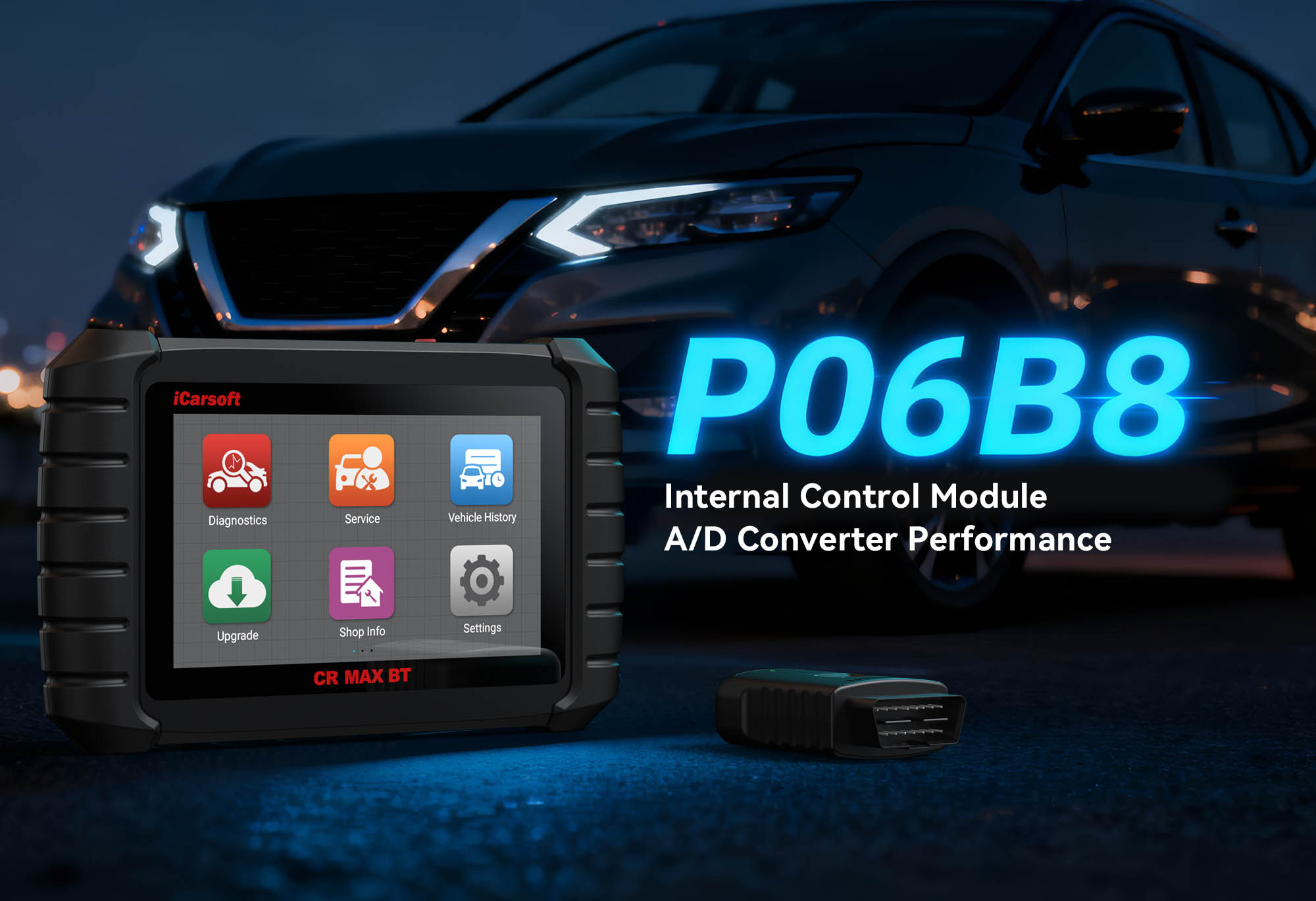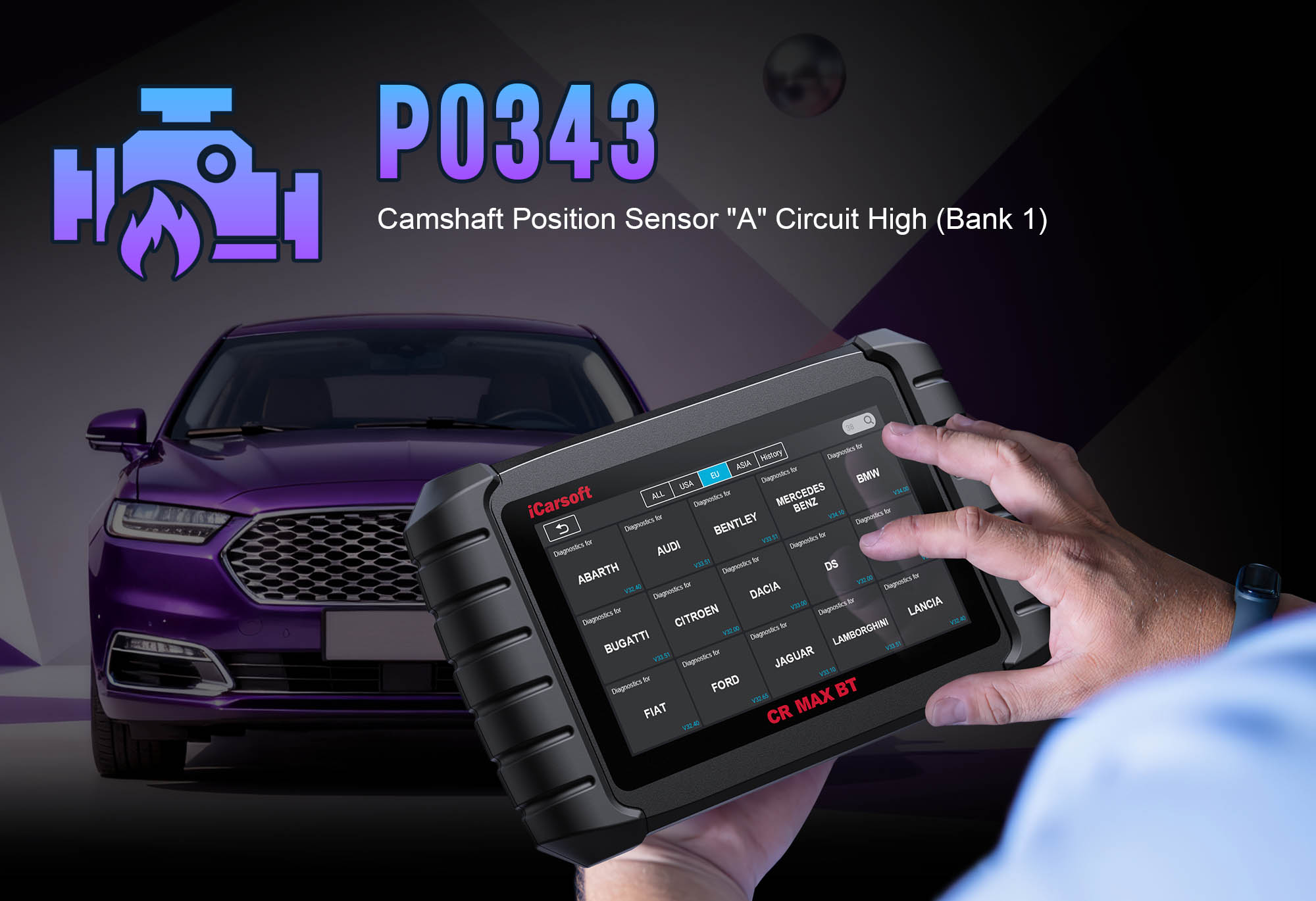Diagnose & Clear P0037 with iCarsoft CR MAX BT
If your vehicle’s check engine light illuminates, you notice poor fuel efficiency, or it fails an emissions test, a diagnostic scan will likely return P0037. This OBD-II code stands for "Oxygen Sensor Heater Control Circuit Low Input (Bank 1, Sensor 2)"—a fault targeting the heater circuit of the downstream oxygen (O₂) sensor (Sensor 2) in Bank 1 (the cylinder bank with the first cylinder in the firing order). The oxygen sensor relies on its internal heater to reach operating temperature (600–800°F) quickly, ensuring accurate monitoring of exhaust gases to adjust fuel-air mixture. When the heater circuit’s voltage drops below the manufacturer’s minimum range (typically 0.5V–1.0V), the sensor can’t warm up properly, leading to delayed or inaccurate readings—and triggering P0037.
Basic scanners might only flag an "O₂ sensor issue" but can’t test heater circuit integrity, isolate wiring faults, or verify sensor responsiveness—leaving you guessing between a faulty sensor, damaged wires, or a blown fuse. The iCarsoft CR MAX BT, with its specialized O₂ sensor diagnostics, real-time circuit voltage tracking, and bi-directional tests, solves this. Let’s break down how to diagnose and resolve P0037 with precision, using the CR MAX BT’s unique features to restore O₂ sensor performance and emissions compliance.
Understanding P0037: Causes & Key Symptoms
The downstream O₂ sensor (Sensor 2) is mounted after the catalytic converter, monitoring exhaust gases to confirm the converter’s efficiency. Its heater circuit—powered by the vehicle’s battery and controlled by the Engine Control Module (ECM)—has two key components: a heater element (inside the sensor) and wiring connecting it to the ECM. P0037 triggers when the ECM detects the heater circuit’s voltage is too low (often <0.5V), indicating a break in power flow or a failed heater element. As the fault persists, symptoms become more disruptive:
Key Symptoms of P0037
-
Check Engine Light (CEL): A steady CEL illuminates, often paired with "O₂ Sensor Heater Low Input" or "Catalytic Converter Efficiency Low" messages (since a cold sensor can’t validate converter performance).
-
Poor Fuel Economy: The ECM uses delayed O₂ sensor data to adjust fuel delivery, leading to a rich mixture and 10–15% lower mileage.
-
Rough Idle/Acceleration: Inconsistent fuel-air mixture causes the engine to shake at idle or hesitate when pressing the accelerator.
-
Failed Emissions Tests: Inaccurate O₂ sensor readings lead to high hydrocarbon (HC) or carbon monoxide (CO) levels, failing state inspections.
-
Catalytic Converter Damage: A rich mixture from a faulty sensor can overheat the converter, reducing its lifespan or causing it to fail.
Common Causes of P0037
|
Cause
|
Description
|
|
Faulty O₂ Sensor Heater Element
|
Internal wear or corrosion in the sensor’s heater coil breaks the circuit, dropping voltage to near 0V—common after 80,000–120,000 miles.
|
|
Damaged Wiring/Circuit
|
Frayed wires, rodent chew marks, or corrosion in the sensor’s power/signal lines (from water or road debris) creates an open connection.
|
|
Blown Fuse/Faulty Relay
|
The O₂ sensor heater circuit relies on a dedicated fuse (7.5A–15A) or relay—failure cuts power to the heater.
|
|
Loose/Corroded Connector
|
The sensor’s 4–5 pin connector (near the exhaust) becomes loose, rusted, or contaminated with oil, disrupting current flow to the heater.
|
|
ECM Malfunction
|
Rarely, the ECM’s internal circuit for controlling the O₂ sensor heater fails, misinterpreting normal voltage as "low input."
|
Why iCarsoft CR MAX BT Excels at Diagnosing P0037
The CR MAX BT outperforms basic tools with features tailored to O₂ sensor heater circuit diagnostics—critical for resolving P0037 accurately:
Wireless Bluetooth Connectivity
Test downstream O₂ sensor (under vehicle) from 30 feet away—no cords hinder undercarriage access or risk hot exhaust contact.
Live Heater Circuit Voltage Tracking
Monitors real-time voltage for Bank 1 Sensor 2 heater circuit, flagging low input (<0.5V) vs. expected values (12V power/0.5–1.0V control).
O₂ Sensor Heater Test
Sends commands to activate sensor heater, verifying current draw and warm-up—distinguishing faulty sensor vs. wiring issues.
AutoVIN Identify
Automatically detects O₂ sensor type (4-wire/5-wire), Bank 1 layout, and heater circuit specs—eliminating manual diagram lookup.
Global Vehicle Coverage
Works with 58+ makes for gasoline/hybrid O₂ sensor systems—OBD-II/OBD-I compatible (with optional adapters).
Circuit Integrity Diagnostics
Built-in multimeter verifies power/ground/signal wire health, isolating fuse/relay faults without guesswork.
Component Location Guides
Pinpoints downstream O₂ sensor, heater fuse, and relay with diagrams—reducing search time for critical parts.
Step-by-Step: Diagnose P0037 with iCarsoft CR MAX BT
-
Safety First & Initial Visual Inspection
1. Let engine cool 2–3 hours (exhaust temps exceed 1,200°F during operation).
2. Locate components via Component Location > Exhaust > O₂ Sensor System:
- Downstream O₂ Sensor (Bank 1, Sensor 2): After catalytic converter on Bank 1 exhaust.
- Heater Circuit Fuse: Engine bay fuse box (labeled "O₂ Sensor Heater").
- Sensor Connector: 4–5 pin plug near the sensor.
3. Inspect for issues:
- Wiring: Check for frays, burns, or rodent damage along harness to ECM.
- Connector: Disconnect, check for bent pins/rust/oil residue; clean with contact cleaner.
- Fuse: Test with CR MAX BT’s Battery Voltage Test—no voltage = blown fuse.
-
Connect Tool & Confirm P0037
Plug CR MAX BT into OBD-II port, select AutoVIN Identify to retrieve specs. Navigate to Engine > Fault Codes > Read Codes to confirm P0037. Tap Code Details for vehicle-specific insights (e.g., "Toyota Camry: Heater Voltage 0.2V, Expected 0.5–1.0V"). Check related codes (P0031, P0057) and resolve P0037 first.
-
Monitor Live O₂ Sensor Heater Data
1. Turn ignition to "ON" (do not start engine).
2. Navigate to Engine > Live Data > O₂ Sensor > Bank 1, Sensor 2; monitor metrics:
- Heater Circuit Voltage: Power wire = 12V, control signal = 0.5–1.0V; P0037 shows <0.5V/0V.
- Heater Current Draw: Normal = 1–3A (0A = open circuit).
3. Start engine, idle 5 minutes—monitor sensor temp (working sensor reaches 600°F+; faulty stays <300°F).
-
Test Heater Circuit Integrity
1. Power Test: Disconnect sensor, multimeter DC Voltage—power pin + ground (ignition ON) = 12V (0V = fuse/relay/wire fault).
2. Ground Test: Multimeter Ohms—ground pin + chassis ground = <1 ohm (>5 ohms = clean ground strap).
3. Bi-Directional Activation: Reconnect sensor, use Special Functions > Engine > O₂ Sensor Heater Control > Activate (Bank 1, Sensor 2)—voltage drop (9–11V) + steady current = working sensor; no change = faulty.
-
Repair or Replace O₂ Sensor/Circuit
- Fuse/Relay Replacement: Install OEM-spec fuse (e.g., 10A); replace faulty relay (Part Lookup).
- Wiring Repairs: Seal frayed wires with heat-shrink; splice broken wires with OEM-grade connectors; use heat-resistant loom near exhaust.
- O₂ Sensor Replacement: Remove old sensor (20–25 ft-lbs torque), apply anti-seize to new sensor threads (avoid tip); install OEM-equivalent (e.g., Bosch 17176); reconnect connector + dielectric grease.
-
Clear P0037 & Validate the Repair
1. Clear Code: Navigate to Engine > Fault Codes > Clear Codes—confirm P0037 deletion.
2. Sensor Relearn: Run Special Functions > Engine > O₂ Sensor Relearn to sync with ECM.
3. Test Drive: Operate 30–40 minutes (highway speeds to warm sensor/converter).
4. I/M Readiness Check: Use I/M Readiness to confirm O₂ sensor monitor is "Ready."
5. Save Report: Document fault/repairs/post-repair data via History & Report.
Preventing P0037 Recurrence
-
Regular Sensor Checks: Use Service Reminder to test heater voltage every 30,000 miles—catch early wear.
-
Wiring Inspection: Check harness every 15,000 miles for heat/rodent damage (especially parked vehicles).
-
Fuse Maintenance: Replace heater circuit fuse proactively every 50,000 miles.
-
Lifetime Free Updates: Use One-Key Upgrade to add advanced O₂ sensor diagnostic features (e.g., heater element wear tracking).
Conclusion
P0037’s O₂ sensor heater low input isn’t just a CEL issue—it risks poor fuel efficiency, failed emissions tests, and catalytic converter damage. The iCarsoft CR MAX BT simplifies diagnosis with wireless convenience, live voltage tracking, and heater activation tests, ensuring you address the root cause (whether a sensor, wiring, or fuse) instead of guessing.
With its global vehicle coverage, 40+ service functions, and lifetime updates, the CR MAX BT is more than a P0037 fix—it’s a long-term investment in keeping your exhaust system efficient and emissions-compliant. Restore fuel economy, pass inspections, and protect your catalytic converter—all with one professional-grade diagnostic tool.





